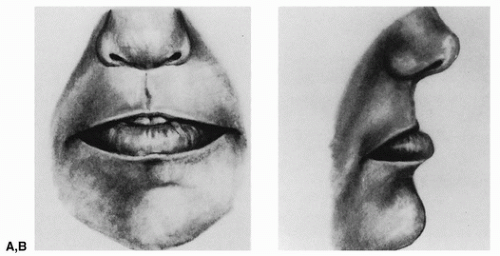Lip Fleur-De-Lis Flap
D. R. MILLARD JR.
EDITORIAL COMMENT
This is a classic technique that attempted to replace the lost central portion of the lip. Such substantial deformities were created when the premaxilla or the columella was sacrificed as part of a cleft-lip repair, a sacrifice that fortunately is no longer made.
Through cancer ablation, radiation, or secondary congenital cleft lip deformities, a relative side-to-side tightness of a lip often occurs. There also may be deficiency in the free border vermilion. One lip may be tight and thin, with only a minimum of vermilion visible. The opposite lip may be loose, with voluminous vermilion in view (Fig. 160.1). In such circumstances, the lip fleur-de-lis flap has been found to be effective in two planes (1).
INDICATIONS
By extending the standard lip-switch flap with lateral mucosal flaps, it is possible to double its dimension of effectiveness. The standard lip-switch portion of the flap will reduce the relative slack of the donor lip while it releases the tightness of the opposite lip.
Simultaneously, the mucosal extensions on the lip-switch flap, taken out of the voluminous vermilion of one lip, are transported and inserted behind the thin free-border vermilion of the other lip. This has a balancing effect because the excessive vermilion is reduced while simultaneously bolstering the deficient vermilion of the opposite lip.
Stay updated, free articles. Join our Telegram channel

Full access? Get Clinical Tree









